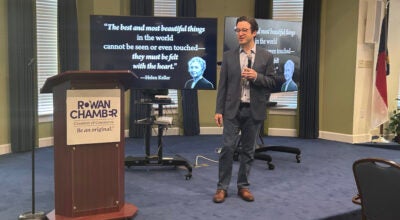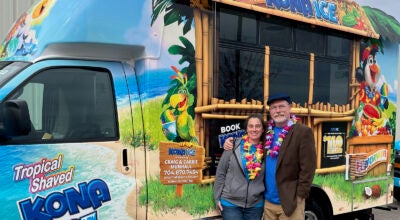Council undecided on controversial rules for trees
Published 12:00 am Wednesday, April 3, 2013
SALISBURY — Controversial new rules intended to protect the city’s tree canopy and reduce air pollution are headed to a committee to determine if they would harm businesses.
City Council members on Tuesday stopped short of approving changes to the city’s landscape ordinance that would require businesses and other commercial developers to plant more trees. While clear cutting would still be allowed, the rules would require developers to have a permit and clean up afterward.
The proposed amendment would not apply to single-family lots, just commercial properties.
After a presentation by city staff, Councilman Brian Miller said council members and developers alike need a better understanding of the changes suggested by the city’s Tree Board.
“Based on feedback, what you are trying to accomplish has been grossly misunderstood,” Miller told Preston Mitchell, the city’s Planning and Development Services manager. “I’m afraid that there is a negative perception of this.”
Miller suggested sending the issue to a committee that would meet with those who have concerns.
“That might be a more effective way as opposed to us just drawing lines,” he said.
Council voted 4-1, with Mayor Pro Tem Maggie Blackwell dissenting. She wanted to vote on the new rules.
As a member of a regional transportation planning group, Blackwell said she is “acutely aware” of Rowan County’s dirty air. Rowan is part of a designated non-attainment area, a large region around the Charlotte with air quality problems.
“Our air quality is awful,” she said. “We owe it to our children and citizens to protect our air quality, and trees are one way we can approach that.”
Although the new rules would not apply to existing businesses and construction already under way — they would be grandfathered — Mitchell used the new Family Dollar going up on Jake Alexander Boulevard by Katana as an example.
Under current city code, Family Dollar had to plant or preserve 28 trees on the 1.25-acre site, compared to 33 trees under the new regulations, Mitchell said.
“Five trees is not going to deter a development,” Blackwell said. “This is not the screeching halt of commerce to Salisbury, North Carolina.”
But Mayor Paul Woodson said his own dry cleaning business, which sits on a 30,000-square-foot lot, could not have accommodated the 18 trees required under the new rules. He said small business owners may have to scale back their planned buildings to make more space for trees.
“I want to make sure what I vote on doesn’t come back to haunt me,” Woodson said.
Mitchell and Blackwell said the amendment would not force developers to downsize their buildings. Protecting the tree canopy would be a source of pride for Salisbury, which is behind cities like Cary and Mooresville, Blackwell said.
During the public hearing, property manager Nathan Chambers said the amendment is a bad idea. It’s cheaper and faster for developers like Childress Klein, which clear cut the property at the corner of Brenner Avenue and Jake Alexander Boulevard for the new Aldi, to remove all vegetation and level the entire property at one time, Chambers said.
Chambers suggested the requirement to plant more trees is “just so something looks pretty from the road” and said it would keep businesses from locating in Salisbury.
“The city would do better to reduce more steps and more hoops you have to jump through to get developers to come to town,” he said.
Tree Board member Johnny Safrit helped write the proposed rules and said they would not deter development but would prevent large areas from being deforested and then abandoned.
Developers who clear cut more than three acres but then don’t build anything would have to plant trees along the street after 18 months.
“Is it fair to everyone else to clear 20 acres of trees and vegetation that support wildlife and quality of air and water quality, and leave that area barren for the next 15, 20 years?” Safrit said. “We tried to come up with a nice balance.”
Developer John Leatherman clear cut nine acres on Jake Alexander Boulevard a few years ago for the fourth phase of his Pinnacle medical office building project. Development stalled and the land remains empty due to the poor economy, Leatherman said, but the project is set to ramp up again soon.
Tree Board Chairman Rodney Queen used photos of the Leatherman property as an example of what city code currently allows.
“It allows developers to sell all the trees and pocket the money and leave all the stuff in total disarray,” said Queen, showing before-and-after photos that depicted a densely wooded acreage, then a wasteland of red dirt and tree stumps in view of low-income housing.
“That’s what we destroyed and left laying,” Queen said.
Leatherman said the photos were misleading because he planted vegetation within two months of clear cutting. The Pinnacle development, including the upcoming phase four, generates taxes and jobs, Leatherman said.
He said he didn’t remove debris from the site because he was told it would trigger erosion control measures, which have to be removed during construction. The proposed rules are punitive, he said.
“This is basically designed to prohibit people from cutting trees and preparing land in advance to be marketed,” Leatherman said, calling the amendment a “significant over-reaction.”
Councilman Pete Kennedy, who serves as liaison to the Tree Board, said he supports the changes but thinks the city has done a poor job of educating people about the importance of trees. He suggested Miller and Councilwoman Karen Alexander form the committee to study the proposed rules.
They agreed, and Alexander encouraged members of the public to attend the committee meetings.
Proposed rules include:
• Property owners who planted trees to meet the landscape ordinance would need permission from the city to remove and replace those trees. Replacement trees would have to meet a certain size.
• No clear cutting on sites larger than three acres unless the city has approved a development plan. Property owners must remove all debris. If owners are developing their property in phases, they could not clear cut and grade the entire tract at once.
• New development must have a 30 percent overall tree canopy. That’s one tree per 500 square feet, or 91 trees for a 3.5-acres site. All trees, including parking lot trees, would count toward the 30 percent.




